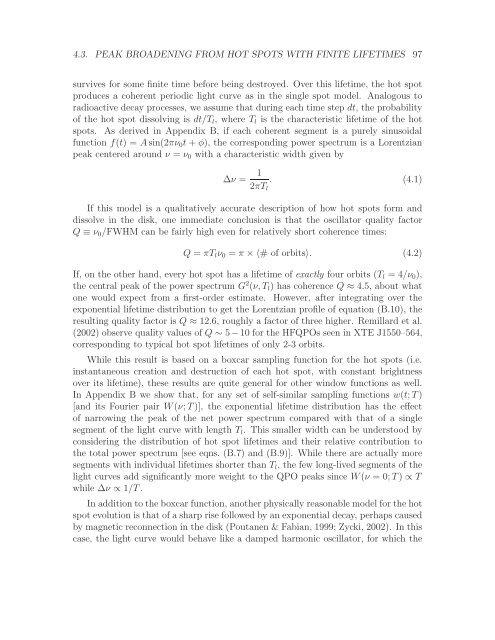Radiation Transport Around Kerr Black Holes Jeremy David ...
Radiation Transport Around Kerr Black Holes Jeremy David ...
Radiation Transport Around Kerr Black Holes Jeremy David ...
You also want an ePaper? Increase the reach of your titles
YUMPU automatically turns print PDFs into web optimized ePapers that Google loves.
4.3. PEAK BROADENING FROM HOT SPOTS WITH FINITE LIFETIMES 97<br />
survives for some finite time before being destroyed. Over this lifetime, the hot spot<br />
produces a coherent periodic light curve as in the single spot model. Analogous to<br />
radioactive decay processes, we assume that during each time step dt, the probability<br />
of the hot spot dissolving is dt/T l , where T l is the characteristic lifetime of the hot<br />
spots. As derived in Appendix B, if each coherent segment is a purely sinusoidal<br />
function f(t) = A sin(2πν 0 t + φ), the corresponding power spectrum is a Lorentzian<br />
peak centered around ν = ν 0 with a characteristic width given by<br />
∆ν = 1<br />
2πT l<br />
. (4.1)<br />
If this model is a qualitatively accurate description of how hot spots form and<br />
dissolve in the disk, one immediate conclusion is that the oscillator quality factor<br />
Q ≡ ν 0 /FWHM can be fairly high even for relatively short coherence times:<br />
Q = πT l ν 0 = π × 〈# of orbits〉. (4.2)<br />
If, on the other hand, every hot spot has a lifetime of exactly four orbits (T l = 4/ν 0 ),<br />
the central peak of the power spectrum G 2 (ν, T l ) has coherence Q ≈ 4.5, about what<br />
one would expect from a first-order estimate. However, after integrating over the<br />
exponential lifetime distribution to get the Lorentzian profile of equation (B.10), the<br />
resulting quality factor is Q ≈ 12.6, roughly a factor of three higher. Remillard et al.<br />
(2002) observe quality values of Q ∼ 5 −10 for the HFQPOs seen in XTE J1550–564,<br />
corresponding to typical hot spot lifetimes of only 2-3 orbits.<br />
While this result is based on a boxcar sampling function for the hot spots (i.e.<br />
instantaneous creation and destruction of each hot spot, with constant brightness<br />
over its lifetime), these results are quite general for other window functions as well.<br />
In Appendix B we show that, for any set of self-similar sampling functions w(t; T)<br />
[and its Fourier pair W(ν; T)], the exponential lifetime distribution has the effect<br />
of narrowing the peak of the net power spectrum compared with that of a single<br />
segment of the light curve with length T l . This smaller width can be understood by<br />
considering the distribution of hot spot lifetimes and their relative contribution to<br />
the total power spectrum [see eqns. (B.7) and (B.9)]. While there are actually more<br />
segments with individual lifetimes shorter than T l , the few long-lived segments of the<br />
light curves add significantly more weight to the QPO peaks since W(ν = 0; T) ∝ T<br />
while ∆ν ∝ 1/T.<br />
In addition to the boxcar function, another physically reasonable model for the hot<br />
spot evolution is that of a sharp rise followed by an exponential decay, perhaps caused<br />
by magnetic reconnection in the disk (Poutanen & Fabian, 1999; Zycki, 2002). In this<br />
case, the light curve would behave like a damped harmonic oscillator, for which the
















